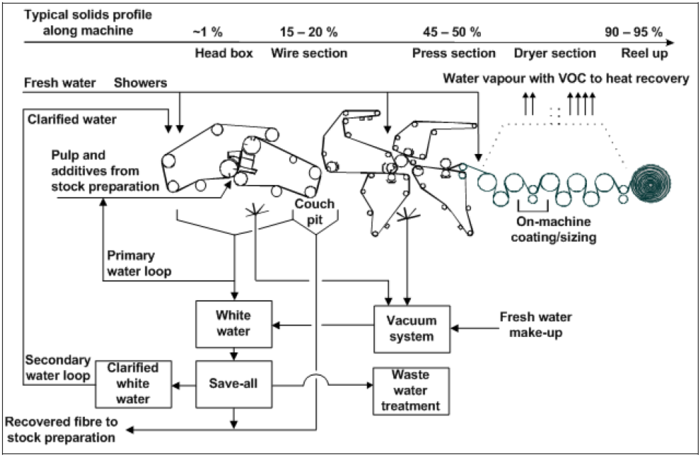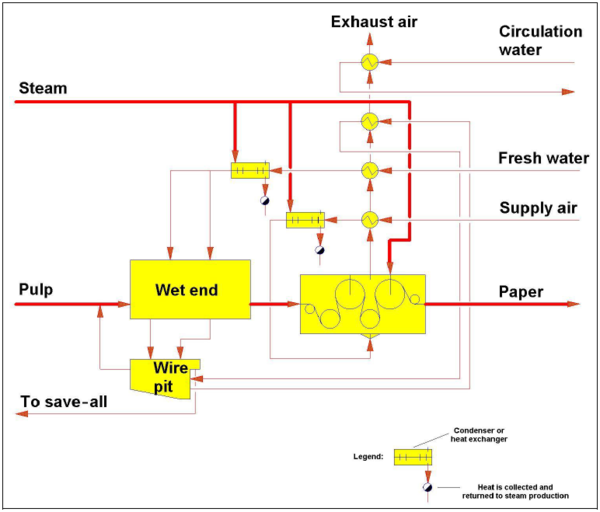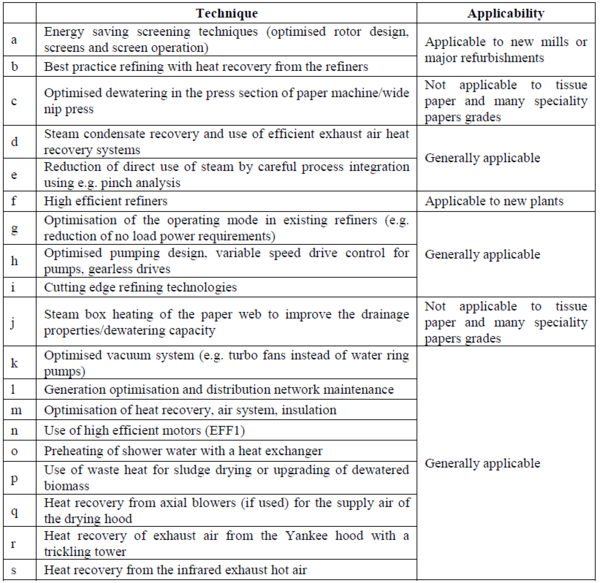Pressing
Back to Subsection DC paper
General Description
In the paper machine, the paper is formed and most of the properties of the paper are determined. The paper machine is actually a large dewatering device consisting of a headbox, a wire section, press section and dryer section. The most common machine design to date is the Fourdrinier forming process in which the sheet is formed onto a continuous horizontal wire or fabric onto which the suspension of fibres is supplied from the headbox. Also, twin wire formers are used for web formation. In twin wire formers, the fibre suspension is fed between two wires operating at the same speed where the water is drained in two directions. There are different types of twin wire formers (e.g. gap formers). In gap formers, the diluted stock is injected directly into the gap between the two wires. A third alternative is to combine the Fourdrinier and a top wire. These are referred to as hybrid formers.
Figure 1 shows the key features of a twin wire paper machine.
Figure 1: Key features of a twin wire paper machine
Paper is made by feeding a dilute suspension of fibres, fillers (optional), dyes and other chemicals onto a fine wire mesh through which the water drains away, leaving a web of fibres, fines and fillers on the mesh. The fibre slurry, which at the wet end of the paper machine is typically between 0.2 % and 1.5 % consistency, is pumped to the wire section via the headbox. The objective of the headbox is to create a uniform dispersion of fibres across the total width of the papermaking wire, in order to achieve a uniform paper formation and grammage distribution. The water drains through the wire aided by 'dewatering elements'. Examples of these are rolls, foils and vacuum boxes below the wire. After typically 10 m, the web of paper is formed. In a twin wire former, additional dewatering pressure is formed by the fabric tension over a curved surface of blades or a roll. By the time the paper web has drained to around 10 – 20 % solids on the wire, the web is self-supporting and can be carried away from the wire and on to the subsequent pressing and drying stages. Machine speeds vary considerably, with the web on the fastest machines, typically newsprint, travelling up to 2 000 m/min with a web width of 11 m. Tissue machines, although generally of narrower width, now run at speeds in excess of 2 500 m/min. Some machines operate with several forming sections for making multi-ply papers or boards.
The paper web passes into a press section supported on felts between rollers and through vacuum sections to remove more water (final dryness of about 50 % moisture content) and then through the drying section. The drying is normally done using steam-heated cylinders enclosed in a hood. In the dryer section, the web is dried to the final dry content of 90 – 95 %. Practically all the heat used for drying ends up in the hood as exhaust air. The temperature of the exhaust air is normally 80 – 85 °C and the humidity is 140 – 160 g H2O/kg dry air. A part of the moisture (about 1 – 1.5 m3/t of paper) is driven off to the atmosphere. For economic reasons, all paper mills have installed heat recovery systems. Figure 7.2 shows a schematic picture of an example of the drying and heat recovery section of a paper machine.
In the first heat exchanger of the heat recovery system, heat is recovered in order to heat the incoming supplied air. The next heat exchanger is for the heating of incoming fresh water. In some cases, heat is also recovered to the wire pit water to compensate for the heat losses at the wet end. The last heat exchanger is for circulation water. The circulation water is used to heat the incoming ventilation air. The supply air and shower water are heated to their final temperatures (90 – 95 °C and 45 – 60 °C respectively) using steam.
Figure 2: Paper machine heat recovery system
Table 1 shows an example of heat flows in a typical large, modern paper machine. The production capacity of the machine is 240 120 t/yr (667 t/d). The dry content of the web entering the dryer section is 44.5 % and leaving is 91 % dryness. The temperature of the exhaust air is 82 °C and the humidity is 160 g H2O/kg dry air. The values are for Scandinavian winter conditions. In countries with a warmer climate, there is no need for the heating of circulation water that is used for machine room heating. Heat recovery to the circulation water decreases or disappears and the exhaust to atmosphere increases correspondingly.
Table 1: Example of heat recovery and heat losses of a paper machine with a production of 667 t/d
One alternative to drying the paper for the production of light-weight machine-glazed paper or conventional tissue is the use of a large diameter, heated 'Yankee' cylinder on the machine. The drying of the paper web is carried out during one rotation of the cylinder.
In a simple papermaking set-up, the paper may then be reeled and sent for cutting and finishing. In more complex cases, a variety of different stages are incorporated within the machine, e.g. a film press where starch and other chemicals are applied on the surface of the paper by dipping or spraying, with residual water being removed in a short after-drying section.
In most applications, the edges of the web are continually trimmed with cutting water jets, into the couch pit, as it leaves the wire. Whenever the web breaks (it can happen a number of times per day), there is a considerable loss of paper. Similar losses occur on regular start-ups. All of this paper, termed 'broke', is repulped and returned to the stock chests in the stock preparation area. Losses of dry paper may be repulped immediately or stored and reintroduced later to the system. Coloured or coated broke is recycled if possible but sometimes needs to be bleached or chemically treated first.
There is a continuous need to prevent the build-up of solids on the fast-moving wires, felts or rollers as these would quickly lead to web breaks. The showers or sprays for this purpose are the primary consumers of fresh water and/or cleaned water in the system. Vacuum systems can also consume substantial amounts of fresh water. However, water-free vacuum systems are also available.
The retention of solids (fibres, fines and fillers) and solubles (added chemicals, organic material from the pulp, etc.) in the paper web, rather than passing them through the mesh and allowing them to remain in the water circuit, is important. It affects the likely destination of any substance – either to the product or to the effluent. On-line consistency monitoring is often used to stabilise retention. The retention of solids on the wire can be increased by the addition of retention aids (chemicals improving retention), and this is normal practice for most paper grades. However, this is constrained for some grades by product quality.
Energy consumption efficiency of paper machine
In order to reduce the consumption of thermal and electrical energy, BAT is to use a combination of the techniques given below.
Source: Best Available Techniques (BAT), Reference Document for the Production of Pulp, Paper and Board, 2015
Back to Subsection DC paper



